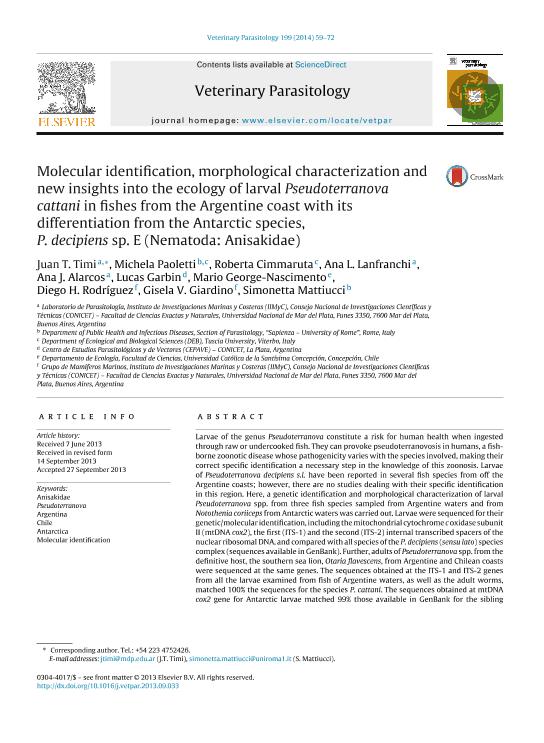Artículo
Molecular identification, morphological characterization and new insights into the ecology of larval Pseudoterranova cattani in fishes from the Argentine coast with its differentiation from the Antarctic species, P. decipiens sp. E (Nematoda: Anisakidae)
Timi, Juan Tomas ; Paoletti, Michela; Cimmaruta, Roberta; Lanfranchi, Ana Laura
; Paoletti, Michela; Cimmaruta, Roberta; Lanfranchi, Ana Laura ; Alarcos, Ana Julia
; Alarcos, Ana Julia ; Garbin, Lucas
; Garbin, Lucas ; George Nascimento, Mario; Rodriguez, Diego Horacio
; George Nascimento, Mario; Rodriguez, Diego Horacio ; Giardino, Gisela Vanina
; Giardino, Gisela Vanina ; Mattiucci, Simonetta
; Mattiucci, Simonetta
 ; Paoletti, Michela; Cimmaruta, Roberta; Lanfranchi, Ana Laura
; Paoletti, Michela; Cimmaruta, Roberta; Lanfranchi, Ana Laura ; Alarcos, Ana Julia
; Alarcos, Ana Julia ; Garbin, Lucas
; Garbin, Lucas ; George Nascimento, Mario; Rodriguez, Diego Horacio
; George Nascimento, Mario; Rodriguez, Diego Horacio ; Giardino, Gisela Vanina
; Giardino, Gisela Vanina ; Mattiucci, Simonetta
; Mattiucci, Simonetta
Fecha de publicación:
01/2014
Editorial:
Elsevier Science
Revista:
Veterinary Parasitology
ISSN:
0304-4017
Idioma:
Inglés
Tipo de recurso:
Artículo publicado
Clasificación temática:
Resumen
Larvae of the genus Pseudoterranova constitute a risk for human health when ingested through raw or undercooked fish. They can provoke pseudoterranovosis in humans, a fish-borne zoonotic disease whose pathogenicity varies with the species involved, making their correct specific identification a necessary step in the knowledge of this zoonosis. Larvae of Pseudoterranova decipiens s.l. have been reported in several fish species from off the Argentine coasts; however, there are no studies dealing with their specific identification in this region. Here, a genetic identification and morphological characterization of larval Pseudoterranova spp. from three fish species sampled from Argentine waters and from Notothenia coriiceps from Antarctic waters was carried out. Larvae were sequenced for their genetic/molecular identification, including the mitochondrial cytochrome c oxidase subunit II (mtDNA cox2), the first (ITS-1) and the second (ITS-2) internal transcribed spacers of the nuclear ribosomal DNA, and compared with all species of the P. decipiens (sensu lato) species complex (sequences available in GenBank). Further, adults of Pseudoterranova spp. from the definitive host, the southern sea lion, Otaria flavescens, from Argentine and Chilean coasts were sequenced at the same genes. The sequences obtained at the ITS-1 and ITS-2 genes from all the larvae examined from fish of Argentine waters, as well as the adult worms, matched 100% the sequences for the species P. cattani. The sequences obtained at mtDNA cox2 gene for Antarctic larvae matched 99% those available in GenBank for the sibling P. decipiens sp. E. Both MP and BI phylogenetic trees strongly supported P. cattani and P. decipiens sp. E as two distinct phylogenetic lineages and depicted the species P. decipiens sp. E as sister taxon to the remaining taxa of the P. decipiens complex. Larval morphometry was similar between specimens of P. cattani from Argentina, but significantly different from those of P. decipiens sp. E, indicating that larval forms can be distinguished based on their morphology. Pseudoterranova cattani is common and abundant in a variety of fish species from Chile, whereas few host species harbour these larvae in Argentina where they show low levels of parasitism. This pattern could arise from a combination of factors, including environmental conditions, density and dietary preferences of definitive hosts and life-cycle pathways of the parasite. Finally, this study revealed that the life-cycle of P. cattani involves mainly demersal and benthic organisms, with a marked preference by large-sized benthophagous fish.
Palabras clave:
Anisakidae
,
Pseudoterranova
,
Molecular Identification
,
Argentina
,
Chile
,
Antarctica
Archivos asociados
Licencia
Identificadores
Colecciones
Articulos(CCT - LA PLATA)
Articulos de CTRO.CIENTIFICO TECNOL.CONICET - LA PLATA
Articulos de CTRO.CIENTIFICO TECNOL.CONICET - LA PLATA
Articulos(IIMYC)
Articulos de INSTITUTO DE INVESTIGACIONES MARINAS Y COSTERAS
Articulos de INSTITUTO DE INVESTIGACIONES MARINAS Y COSTERAS
Citación
Timi, Juan Tomas; Paoletti, Michela; Cimmaruta, Roberta; Lanfranchi, Ana Laura; Alarcos, Ana Julia; et al.; Molecular identification, morphological characterization and new insights into the ecology of larval Pseudoterranova cattani in fishes from the Argentine coast with its differentiation from the Antarctic species, P. decipiens sp. E (Nematoda: Anisakidae); Elsevier Science; Veterinary Parasitology; 199; 1-2; 1-2014; 59-72
Compartir
Altmétricas



